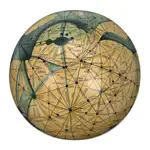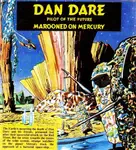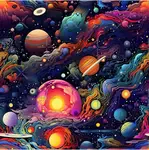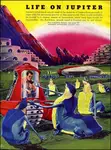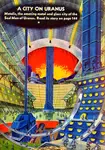the sunport vista:
zendexor's
oss
diary
2025
The Samuel Pepys of the OSS...
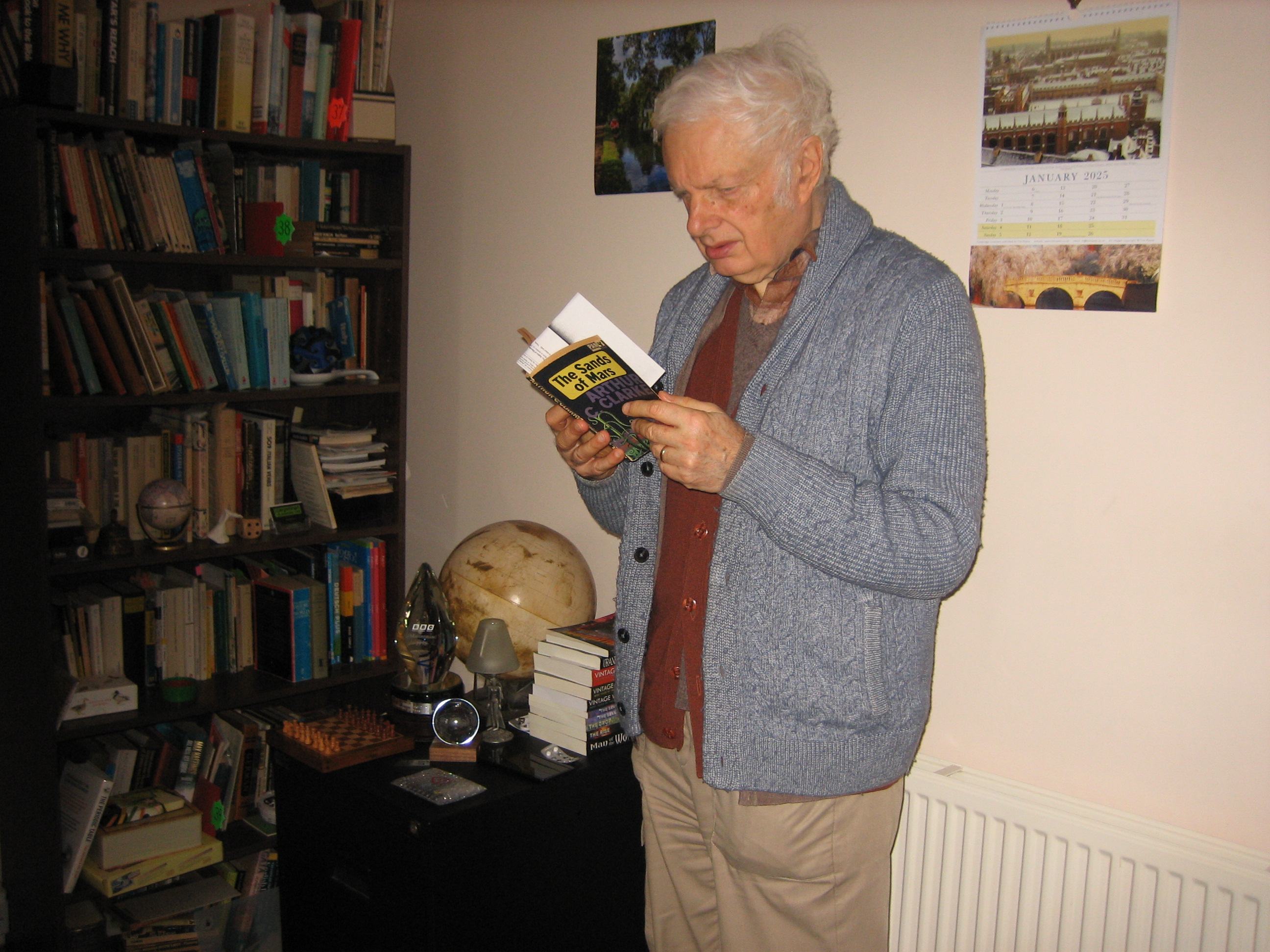 Zendexor lost in The Sands of Mars
Zendexor lost in The Sands of Mars2025 December 6th:
SPIN-OFF FROM THE BARSOOMIAN ATMOSPHERE PLANT
It produces more than just oxygen - it yields a useful analogy.
The topic: freeloading.
The savage green men of Barsoom play no part in supporting or
maintaining the air-factory run by the red men. And yet, all denizens
of the Red Planet without exception, (er... except perhaps the
kaldanes,) rely on the installation's continued functioning.
Thus
the green men "ride on the bus without paying the fare", so to speak.
In fact their actions tend if anything to obstruct the running of this
most vital "bus", yet they are not specifically punished for this, or
for their generally unco-operative natures, but are allowed to go on
benefiting from a service which they do nothing to support and on which
their lives depend.
They are, in short, successful freeloaders.
The situation has great potential as an analogy to clear up certain
historic religious disputes. I'm thinking of an unnecessary "either-or"
in the history of Christian controversy, which used to crop up
frequently when attention was focused on the fate of unbelievers. To
the unbelievers themselves, of course, it was not a problem. But the
question often led the Christian mind into a trap. It went: "Either
the Church is essential for salvation, in which case there is none
outside it, and unbelievers are doomed. Or, the Church is not essential
for salvation, in which case its claims are not true."
You see the fallacy? "Either the Barsoomian green men help maintain the oxygen factory, or they asphyxiate." Or alternatively, "Either all Barsoomians must co-operate to keep the plant running, or else, if a number of them don't, the thing can't be really necessary after all."
Both of these ignore the third option, which is that the oxygen factory /
Church is indeed essential for salvation, but that this indispensability doesn't mean you are
asphyxiatingly damned without it.
You are allowed to freeload.
2025 December 5th:
THE PROTO-MORLOCKS OF SUSSEX
Margaret Drabble in her A Writer's Britain: Landscape and Literature (1979) informs on page 51 that
...the country house of Uppark, where H. G. Wells' mother was housekeeper, was built with the servants' quarters landscaped out of sight, underground, because their intrusive presence would spoil the view...
Reading this made me sit up! I had known that Wells was making a social point in The Time Machine (1895) but I hadn't known of this remarkable echo of the underground theme.
Of course, the echo is a necessarily distant one. It's a long, long
stretch from the nineteenth century to the far future year 802,701 when
the Time Traveller arrives to find that the Morlocks, remote
descendants of the labouring classes, have evolved into a distinct
species who prey upon the childlike, mentally feeble Eloi, descendants
of their "betters".
...Ages ago, thousands of generations ago, man had thrust his brother man out of the ease and the sunshine. And now that brother was coming back - changed! Already the Eloi had begun to learn one old lesson anew. They were becoming reacquainted with Fear...
On reflection I'm quite glad that earlier in my reading life I hadn't known about the remarkable coincidence which Drabble mentions. Today it's a fine, positive addition to my feelings about Wells' writing - now that I can find such a point interesting without allowing it to detract from the pristine wonder of his tale. No danger, now, of thoughts about the source-influence tainting the narrative with a pernicious kind of voice-over or pictorial overlay that usurps the freshness of the vision.
If, however, as a boy during my first reading of the Time-Traveller's adventure I had also learned of the Uppark connection, it would have been too much as if my first reaction to a movie had suffered the interference of an accompanying commentary on how its special effects had been achieved.
2025 November 29th:
MAKING ROOM FOR CHAOS
Occasionally
we find that the setting of a fictional planet leaves us uncertain: is
it in our system's family or is it extrasolar?
In a case where it somehow feels
right for the Solar System despite the evidence being scanty or
ambiguous, one is tempted to argue like a clever lawyer to make a case
for its inclusion in the OSS.
The most tantalising instance I know of
is in J G Ballard's The Waiting
Grounds; see Where the heck is Murak?
Slightly easier, but still problematic, is the fictional outermost planet named Chaos in William Spencer's The Eternal Machines (New Writings in SF-2, ed. John Carnell, 1964).
I say it's an easier case than Murak, solely because Chaos is
explicitly stated to be the system's outermost planet. That ought to
make it a cinch for inclusion. After all, think of the huge latitude
granted to writers, to invent any sort of transplutonian Planet X they
like!
The motivation to include Chaos is all the greater because it's full of character, though lifeless except for its Warden.
...All right, so he had got just about the loneliest job in the whole system. He liked it that way.
He, Rosco, was the sole human inhabitant of Chaos: a trillion tons of
planet with several million tons of assorted junk littering a large
part of its sterile surface.
Chaos was the municipal rubbish dump
of the whole system. Only they didn't call it a rubbish dump any
more. It went by some polite new name. Spoil tip...? Infill zone...?
That was it.
Robot ships shuttled in regularly from the more
favoured parts of the system, bringing with them a capacity load of
obsolete and unwanted junk of all kinds... The dented detritus of the
march of progress...
The ships came in, unloaded their quota of junk, and scooped up a load of high-grade niobium ore. Then they were off again.
Weight of ore removed exactly balanced the incoming mass of junk.
And so Chaos remained nicely in her orbit, not nudging inwards towards
her more lovely sisters, or swinging outwards on a flighty new orbit in
the depths of space.
Rosco looked out now at the ship safely sitting on the landing apron, enshrouded in shimmering waves of heat...
Stid: I see what you mean, Zendexor: Chaos as an outermost planet of our System sure does present problems!! Shimmering waves of heat, on a world beyond Pluto, forsooth! Even your excuse-making powers must be challenged by that. What are you going to say - something about radioactive heat seeping up through the planet's crust?
Zendexor: I suppose so. Perhaps not quantitatively plausible, but then OSS lliterature is more like topology than arithmetic... for example a "trillion tons of planet" is a slapdash use of words; Earth weighs about six billion trillion. If the heat measurement in the tale could be granted a similar vagueness-allowance we'd be home and dry! Unfortunately, heat has a qualitative effect on the picture we're given. And the heat isn't the only problem. In the following passage you'll find two more.
It was three hours after dawn when Rosco rose again, the light
streaming into the sleeping quarters through the round window...
The big freighter had gone, and it would be three days before another came smouldering in down the landing beam.
Each day on Chaos was thirty-five hours long. The sun gleamed, a
pale disk, through the high layer of grey dust that hid the stars at
night...
You see? Light streaming in... and the Sun a pale disk. In reality, at Pluto's distance the Sun would appear as a point of light about one arc minute in angular diameter, and thus it would look even smaller from some planet further out.
Stid: Let me help you with your topology, Z. Let's say Rosco has got accustomed to the dimness which after all is still 250 times brighter than the full Moon at Pluto's distance, and so maybe about 60 full Moons from twice as far. That could be enough sunlight to seem bright to a veteran habitué, or so we can hope for the sake of the story. Now, as to the apparent disk-diameter, let's assume it has been somehow - let me see - magnified through refraction due to some special quality of the Chaotic atmosphere.
Zendexor:
I'm proud of you, Stid. We may have had our differences, but when the
chips are down you are prepared to bury the hatchet and rally round the
flag. One problem remains for us to address, and that's the question of
implied context: interplanetary versus interstellar. You see, it
might be argued that Chaos is merely the dump for one System among many,
rather than a facility for all mankind. And if it just serves the
needs of one System among many, it may well happen not to be our System
at all.
Here it may help to note that the words "interstellar"
and "galaxy" don't occur anywhere in the text, so far as I can recall,
whereas the word "interplanetary" occurs several times. That tends to
suggest that the author imagined his story to be set in our System. The
other difficulties may have sprung from a sheer lack of concern with
such details.
Stid: Quite so. William Spencer was determined to write a moving story and he didn't give a damn about scientific accuracy beyond a certain basic level. Chaos has an unbreathable atmosphere and therefore Rosco goes around wearing a helmet: that's about as realistic as it gets. So you can go ahead, Zendexor, and mark down a passage in the tale for future use in Guess The World, followed by its inclusion in What To See on Planet X!
Zendexor: That's what I've been after all along; I wanted Chaos to feature on those pages. But unfortunately having failed to extinguish all doubts, while still tempted, I don't quite dare. Of course some day I may grasp the nettle...
Note added a few minutes later:
Jumping ice-cats of Pluto! Going to the authors page to do a link to this Diary entry I find I have already written about A planet named Chaos in a previous entry in 2022! Only, at that time it seems I was unquestioningly prepared to accept the world as being in the Solar System; evidently my critical attitude has sharpened since then - getting skeptical in my old age...
2025 November 21st:
FUTURE ANTERIOR
It's
probably a truism by now, that the sensations some people of my age had
with regard to what used to be futuristic-sounding dates can be
reawakened by reading stories which feature forward speculation about
those dates.
Thus, for instance, when last night I read the 1973 tale All the Bridges Rusting, set in 2035 but with plentiful references to 2004 and 2018, for a while I was able to recapture the sense of wonder of gazing forward at 2004 and 2018.
Ah, 2004! Almost a magical number, thinks my 1973 self! And Larry
Niven who wrote the story may have experienced something like the same
emotion.
Whether he seriously believed it was possible to have
teleportation as a public transport system and interstellar flight by
that time, I don't know. It would be interesting to ask him. Perhaps
he would have said, "Unlikely but not impossible".
The point is, though, that he did
put these developments in the story, and therefore must have believed
that they were not so ridiculous as to make it artistically
unviable.
You might suggest that he put the
date so early because he wanted to set the action in a society not too
far from the one we know. However, that objection doesn't really work
for Niven, who is quite able to work out social as well as technological
changes for his plots. If he envisaged the first interstellar flight being launched in 2004, then he must have thought at the time of writing
that the idea was not absurd.
Thus we can use fictional dates to
tell us something about the real world of the era in which they were
thought up. The optimism! Think of Clark Ashton Smith's Martian colony of 1980 (in Master of the Asteroid). Of Arthur C Clarke's Mars landing in 1984 (Transit of Earth). And many others.
We can class Niven's 1973 story, then, as one more piece of evidence that those days, just over half a century
ago now, still permitted belief in the steepening curve of progress
which had made 1970 so much
more different from 1920 than 1920 was from 1870.
Larry Niven wasn't to know of the subsequent slowdown, whereby the level of progress
by 2020 turned out to be not so drastically different (except, of course, for cyberspace) from that of
1970...
2025 November 5th:
TWO CONTRASTING HE-MEN
A
tendency exists amongst unappreciative critics, to assume that a pulp
writers' heroes are all cut from the same cloth. The assumption is not
valid: the similarities hold for some but not all. Take the tales of Robert E Howard:
the reader can hardly fail to notice the huge difference exists between
the characters of Conan and of Solomon Kane. Now let's consider a
contrast between Burroughs' two best-known heroes.
First, from Llana of Gathol (p.50):
"It is gone," I said.
"Hin Abtol," said Llana of Gathol. "The coward abandoned his men and
fled in your flier. Only two of his warriors succeeded in accompanying
him."
"Perhaps he would have been a fool to remain," I said. "He would only have met the same death that they met."
"In like circumstances, John Carter would have been a fool, then," she shot back.
Perhaps I would, for the truth of the matter is that I like
fighting. I suppose it is all wrong, but I cannot help it. Fighting
has been my profession during all the life that I recall...
Second, from Tarzan the Magnificent (p.156):
"If you are not back within a reasonable time," Thudos told him, "I shall send an army to Athne to bring you back."
"If I am not back in a reasonable time," suggested the ape-man, "it may be because I shall be dead."
"Perhaps," agreed Thudos, "but they will not kill you unless they
have to. They are always hard pressed to find enough slaves to carry on
the work of the city, and they'd never destroy such a fine specimen as
you. Like us, they also need men to fight in the arena."
"You would like that better than scrubbing elephants," said Gemnon, smiling.
Tarzan shook his head. "I do not like to fight or to kill, and there are worse things than scrubbing elephants."
The difference could not be more dramatic. And one could go into all kinds of alleyways of argument from here, some of them obviously moral, and some "merely" literary - such as, it tends to show that the theme of clean and virtuous barbarian versus corrupt civilized sophisticate manifests itself even when the civilized man is as honourable (in his own terms) as John Carter.
Stid: All right, Tarzan shows up comparatively well from the comparisons you've quoted above. Yet (in his young days at any rate) the ape-man was not above playing lethally cruel pranks on his enemies.
Zendexor:
True. Perhaps life with Jane subsequently mellowed him. But the main
point I was making, was not about who is the better man, Tarzan or
Carter. I was, instead, concerned with the critics, in particular the
mistake made by those who seem not to have opened the books over which they
spout their generalizations; or, if they have got so far as to turn the
pages, seem not to have taken much note of the words printed on them.
This theme - of not actually reading the stuff you're supposed to be critiquing - is endemic in certain realms of the literary continuum, and I'm sure I've grumbled about it before; let me allude once again in particular to those who spout fallacies and misapprehensions about James Bond and the works of H P Lovecraft. I'm not talking here about failure to appreciate style, which is so largely a matter of taste, but of misreading the actual content, the nature of which is not a matter of taste but of fact.
Stid: You might also mention John Buchan.
Zendexor: Right, absolutely right! What do most people think of when they think of Buchan's works? Richard Hannay and The Thirty-Nine Steps. Not bad in some ways (especially if you can tolerate Hannay's prejudices for the sake of the context), but really, what about the great short stories, and the historical fiction e.g. the masterly and eerie The Blanket of the Dark, and the superb supernatural The Gap in the Curtain... and so on and so on? To ignore these is a tragic waste of good reading time.
2025 October 27th:
A FRUITFUL LAG
Quite apart from those OSS die-hards like myself who don't give a damn, there exist some more scientifically-scrupulous authors who merely allow themselves on occasion to fall behind the times.
Literature is indebted to them for the opportunities afforded by these lapses into ideological obsolescence.
I recently came across a striking example in a tale by Mack Reynolds, The Man in the Moon (Amazing Stories, July 1950), about an astronaut with an inferiority complex who is chosen for a dangerous pioneering lunar mission. The paragraph I shall quote from here is almost a compendium of cute and superseded ideas about the Moon - ideas which were surely no longer taken seriously in 1950 (just as the Martian canals were, by then, probably no believed in by professional astronomers, though I dare say some doubts on the issue did linger).
...he had no time for seeking the answers to the problems which had baffled the astronomers so long. No time to discover the true nature of the rills and rays. No time to explore the Crater Plato to find if there was moisture there; no time to discover the nature of the smooth floor of the ninety mile long Great Valley; no time for the snow storms on Mount Pico, nor the possible clouds or vegetation in Eratosthenes Crater. No time for any of the riddles of the moon...
Fortunately, there's nothing to stop we readers from having time for them!
2025 October 13th:
SELF-CONTRADICTION - THUMBS UP OR DOWN
Here are two passages, both from the same narrator:
...I do not know why I should fear death, I who have died twice and am still alive; but yet I have the same horror of it as you who have never died, and it is because of this terror of death, I believe, that I am so convinced of my mortality...
- A Princess of Mars (1912), chapter I
...This, I thought, is the end, as the great carnivore came racing at me. As suddenly as he had entered the room, he came to a stop a few feet from me, and so instantly that he was thrown to the floor at my feet. It was then that I saw that he was secured by a chain just a little too short to permit him to reach me. I had had all the sensations of impending death - a most refined form of torture. However, if that had been their purpose they had failed, for I do not fear death.
- Llana of Gathol (1948), book 2, chapter 4
Well, does John Carter fear death or doesn't he? Of course, the two scenes are widely separated in time, both from the character's point of view and in the author's career. Still, the contradiction is quite emphatic. It couldn't be starker.
Stid: ERB just forgot, that's all. Give the guy a break! He wrote so much...
Zendexor: He sure did, and my view, naturally enough, is that the inconsistency originated in
the author - he just forgot in the 1940s what he had written three
decades earlier; the result being that the character of Carter is made
to contradict himself. Yet this raises the whole rather vital question of inconsistencies in the Barsoom books. Such a phenomenon can
either detract from a series or add to it.
If the inconsistency
is too obtrusive, forcing itself repeatedly on the reader's attention,
then I give the work the thumbs down. If on the other hand there's just
enough of it to give the scene as a whole a sort of promising blur, so
that constraints which might otherwise slam down are left like doors
ajar, generally in tune with the dreamily ramshackle relaxedness of the world-building as a whole - then I'm more likely to give the works the thumbs up.
Stid: The "just enough" sounds rather unquantifiable!
Zendexor:
Well, what do you expect? If it were that easy to pin down, we might
make a formula out of it and all become as successful as Burroughs! No
chance of that - but we can at least take care not to point an
automatically accusing finger whenever a self-contradiction pops up. It would be a shame to miss out on an asset: and it's best to bear
in mind that what
would otherwise be a flaw can indeed count instead as an asset, provided a critical mass of world-building value has been achieved, enough to turn flaws into summonses for the reader's co-operation!
It's the old excuse-enlistment power at work again.
2025 September 24th:
SWORDS AND SPACESHIPS - IT COULD HAPPEN
Consider the following passage from A E van Vogt's Empire of the Atom (p43-4):
...At midnight on the second day, the vessels proceeded ten abreast
towards the canal and the city. A site some five miles from the city's
outskirts had been selected, and, one after another, the lines of ships
settled among the brush and on the open fields. They began immediately
to discharge their cargoes - all the soldiers, most of the horses and
enough equipment and food for a considerable period.
It was a
dangerous six hours. Spaceships unloading were notoriously vulnerable
to certain types of attack ships fitted with long metal rams, capable of
piercing the thin metal plates of which the outer walls were
constructed. For an attack ship to catch a transport in the air meant
almost certain death for everyone aboard...
...The six hours
passed without an attack. About two hours after dawn, the army began to
move along the canal towards the city. When they had marched about an
hour, the advance guards topped a hill overlooking a great valley beyond
which was glittering Oslin. They stopped, rearing their horses. Then
they began to mill around. Swiftly, a messenger raced back to Lord
Greg, reporting an incredible fact. A Martian army was encamped in the
valley, an army so vast that its tents and buildings merged into the
haze of distance.
The general galloped forward to have a look...
....Lord Greg had already made up his mind to attack at once, when a
small fleet of enemy attack ships whisked over the hill, and discharged a
shower of arrows...
I've discussed elsewhere some of the issues raised by this book - see Just inside the borderline and Fail-safe consequences - but here I wish to stress further that its scenario is not as ridiculous as it may seem.
Stid: Why bother? Aren't you and your readers inured to the ridiculous anyway? Oh well, let's hear the latest product of your excuse-factory.
Zendexor:
No but really, it could happen. I mean it seriously, and not
necessarily as a consequence of the excuses van Vogt makes for his mix-up culture of horses and bows and arrows combined with spaceships and an invasion of Mars. His tale
presupposes the aftermath of an atomic war if I remember correctly
(Empire of the Atom takes place in about 12,000 A.D., about 8,000 years
after the fall of the previous civilization) and the resulting confusion and partial loss of continuity. I'm saying that the swords-and-spaceships mixture could happen without
all that - merely through a natural development of society.
Even right now, in our world of 2025, it's becoming easier to believe that
technology is acquiring its own momentum to carry it beyond the understanding of its creators.
I'm not just referring to Artificial Intelligence. The possibility
exists that any operating system is liable to get so complex, the day may
come when nobody understands how stuff works.
Stid: Well then, in that case, mankind will naturally trim his sails, or rather have his sails trimmed for him, and will stop being able to make the stuff.
Zendexor: Yes but, it's not certain that our decision-makers will be so stupid as not to see what's on the way and take steps to provide for it.
Stid: You mean, to prepare for a culture in which nobody needs to understand how stuff works -
Zendexor:
- Precisely - prepared in good time - and it'll be a culture in which the incomprehensible workings don't need human maintenance! For examples,
spaceships will be self-repairing and idiot-proof, so they'll stay good. On the other hand,
the same far-sighted decision-makers who provide for that may also
provide for far more primitive weaponry. The idea may be:
"Look, we can't rid Man of his aggressive instincts, but we can make
sure his weapons aren't too destructive. Since we're building a culture
in which technology is used without understanding and without further
development, we'll fix weaponry at the medieval stage, while for
comfort's sake other technical stuff is far more advanced."
Hence - swords and spaceships!
2025 September 15th:
PORTRAYING JOHN CARTER
Every
now and then, when picking out one of the Barsoom books to reread, I have
tended to omit two of them from consideration. One of the omissions is not surprising -
it's the sub-par fourth volume, Thuvia, Maid of Mars. But the other,
which I'm about to correct by giving it another read, is the first of
the ten: A Princess of Mars. Why have I comparatively
neglected it? Perhaps it's that I've considered the opening volume as more of a mere scene-setter
for the rest of the saga, than as a tale in its own right; in which case the sooner I correct that stupid stance of mine the better.
Be that as it
may, one theme hit me from the first page onward with more force than
ever: the terrible mis-casting of Taylor Kitsch as the actor playing
Carter in the 2012 movie. Or perhaps it's not so much the actor's failure as it's the fault of the screen-play,
and TK could have done better given the chance. At all events the film's moody, scruffy protagonist is unrecognizable as the Burroughs hero who
...seemed always to be laughing; and he entered into the sports of the children with the same hearty good fellowship he displayed toward those pastimes in which the men and women of his own age indulged...
Stid: Hang on, shouldn't you be making allowances for the guy's ordeal as a prisoner of the Union army? It could have soured him.
Zendexor: That brings up what I said earlier, about the screenplay. For Carter never was a prisoner of the Union army. But even if he had been, he would have reacted with more dignity and polish.
...His manners were perfect, and his courtliness was that of a typical southern gentleman of the highest type...
Now be honest, can you put your hand on your heart and say that truly amounts to the impression one gets from the Taylor Kitsch performance? Quite honestly, I reckon that in the movie Carter's Zodangan enemy SabThan shows more dignity than the "southern gentleman" who our hero is supposed to be.
Stid: So you insist on this dismissive verdict, Z.?
Zendexor: I do, and in so doing I'm bearing in mind how it exemplifies a lamentable tendency to de-dignify heroes in movies. Think of the disastrous portrayals of Denethor, and to a lesser extent of Aragorn, in the Peter Jackson version of The Lord of the Rings. I dare say it's tempting to avoid the challenge of portraying dignity combined with toughness, and to take the cheap route whereby toughness is evoked via belligerence and violence of manner, but it's a hell of a let-down.
There, that's that off my chest.
Stid: Well now, I see your point re Aragorn, but Denethor in the film doesn't show belligerence or violence, he is just a bit of a slob, dribbling fruit juice down his chin...
Zendexor: All right, but that's just a different illustration of my general point about evading the challenge of dignity. In the case of Denethor, the challenge was to capture Tolkien's unforgettably brilliant portrait of a powerful heir to an ancient civilization; a man of great dignity but eaten away from within by the decadence of misguided despair. Jackson "solves" it by substituting a different decadence - the chin-dribble - as a sort of short-cut symbol. Yuck! Hitchcock would have done it far, far better.
Come to think of it, Hitchcock would have done John Carter better too.
2025 September 2nd:
THE EXCUSE-DIAL TURNED TO MAXIMUM
I recently re-read the passage in the Captain Future novel Outlaw World about the cave-apes of Asteroid Zuun.
It furnishes a great example of how, in the court of literary appreciation, the verdict must come first and the trial afterwards. In the case of Outlaw World's asteroidal cave-apes, the verdict is an acquittal. And because it comes before the trial, we are able to ignore the mountain of evidence which the prosecution would otherwise bring to bear.
As to the nature of this adverse evidence - well, it's overwhelming. Even by the standards of the Old Solar System the lack of realism in Hamilton's tale is breathtaking. I'd go further and say that in fact it's breathtaking even by the standard of Captain Future settings.
Consider what we have to suspend disbelief on: an asteroid which not only has a breathable atmosphere and living conditions fit for a human visitor, but also has a weirdly topsy-turvey ecology, consisting of a lot of bulky carnivorous cave-apes which apparently have nothing to eat but lichens (and no doubt the occasional visitor from space). An odd food-chain, to say the least.
Now, this is where the excuse-dial is twiddled to full power on the excuseometer.
Here we go:
If physicists can talk about "virtual particles" that pop in and out of existence without a pedigree of causation, then we OSS fans ought to be allowed belief in a "virtual" anything that pops into an existence similarly lacking in aetiological justification.
The cave-apes owe their being to a justification of another kind. They have sprung into existence because of the requirements of the plot.
That is a powerful reason, believe me. The "don't argue" field created by the plot-force is so strong that no other force can possibly stand against it.
Let therefore the cave-apes leave the court without a stain on their legitimacy, vindicated for the up-keep of peril on Zuun.
2025 August 13th:
A GLIMPSE OF THE PREHISTORIC MOON
The remarkably fuzzy chronology of Hawksbill Station (Galaxy, August 1967) makes it hard to decide whether the glimpse of Luna it affords should be regarded as that of a billion years ago or of about half that amount of time ago.
The tale is set on Earth during the "late
Cambrian period", and seems accurately described for that, but Robert
Silverberg's characters persistently refer to their exile as "a billion
years" pastwards of when they were sent, whereas 500,000,000 years is the right round figure.
Stid: As though the author regards a billion as meaning merely "a hell of a lot". But perhaps we should blame the characters - maybe it's they who don't care how chronologically inaccurate they are.
Zendexor: Possibly so, but on the other hand the political fanatics of Hawksbill Station are bright enough, which is why as trouble-makers they were sent to the Cambrian, and their various leftist ideologies are by and large the sort that claim to be scientific. So it looks as though it's Silverberg who doesn't care what a billion is - or else doesn't care when the Cambrian was. Now, the reason I bring this up here is the glimpse we get of the Cambrian Moon. The conversation springs from a remark by Lew Hahn, a recent arrival at the Station.
...Outside, Hahn peered up at the moon. It was nearly full tonight,
shining like a burnished coin, its face a pale salmon colour and hardly
pockmarked at all.
"It looks so different here," Hahn said. "The craters - where are the craters?"
"Most of them haven't been formed yet," said Barrett. "A billion
years is a long time even for the moon. Most of its upheavals are still
ahead. We think it may still have an atmosphere, too. That's why it
looks pink to us..."
Stid: I see what you mean about the author's attitude, Zendexor. The naked eye cannot spot craters on the Moon! We may think it possible that one educated character might believe it's possible, but two of them accepting that idea? Nah.
Zendexor: Anyhow, it brings us another fuzzy historical inaccuracy - but this one is more fruitful from the Old Solar System point of view. I refer to the idea that the Moon might still have had an atmosphere a billion (or half a billion) years ago. Quite impossible, for it's simply not true that at that time "most of its upheavals are still ahead". Admittedly the craters Copernicus and Tycho were still to form, but the great maria had already been lava-flooded ages before, and thus the Moon's appearance from Earth would have been about the same as now (though probably it would have looked discernibly larger, being closer than it is now - an evocative point which Silverberg overlooks). Yet please don't think I am complaining - I like the fuzzy approach here! It brings that much closer the desired overlaps with tales of the ancient inhabited moon.
Stid: But the
novella makes no mention of any chance of life on the moon -
Zendexor: True, but as we read it our imaginations begin to hop.
2025 July 16th:
ALLIED ARTWORK
A day or two ago I was about to do a Guess The World with this Plutonian scene by the artist David A Hardy:
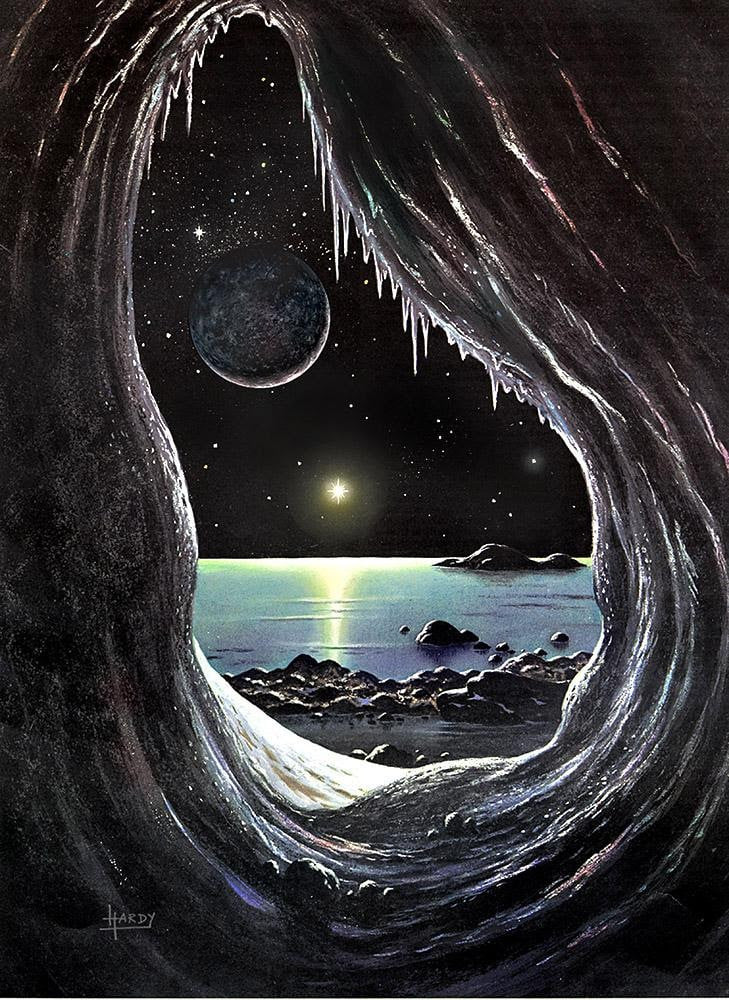
I'd uploaded the picture and was just about to do the GTW entry when the voice of caution stayed my hand. "Wait," said the voice, "this isn't OSS - this is realism!"
Ah, but what about sterile lunar landscapes which are allowed to be OSS?
Ah, but the Moon is a special case. For a long time before the Space Age we had tales featuring the more or less real Moon. The OSS aspect in those cases was not the nature of the destination so much as the means of getting there, or the existence of lunar bases coterminous with pre-yuck cultures on Earth.
Ah (arguing with myself again) but can't Pluto be a special case too?
Well, if the David Hardy painting had had an old-fashioned spacecraft in it, maybe... but the scene contains nothing but rock and frozen gas.
Ah, but - one last attempt at inclusion:
It's such a pretty picture!
2025 June 29th:
WANDERING OFF THE POINT
Not exactly an apology, rather in hope that I'll be forgiven for not apologizing, here's an admission of (coupled with an excuse for) the way some material on this site is not directly to do with the Old Solar System.
Obviously, the Stellar Neighbourhood page is a case in point. But also, I don't scruple to include many extra-solar events on the Fictional Dates timeline. And then there's the most recent page, devoted to Future dates for real, which isn't even fictional at all. That was also true of the column by the late and sorely missed Jamie Ross, The Reality Distortion Field.
Fact is, I can't resist allowing the overspill into other territory: it's all such fun. But let me assure any reader who may feel disquiet at such distension, that the extra-solar stuff will never catch up in volume with my coverage of the OSS. You can trust that this website's centre of gravity will remain in our System. So when the next "irrelevant" page arrives on the scene, as I expect it to do soon, just shrug and say to yourself (Marcus Aurelius style), "it's all part of the great web".
Indeed, that ultimate running-together of all great things, of all vistas of space and time, is what makes the "spread" defensible on thematic grounds. For instance, if you love astronomy the chances are that you love sf, and, thence, that you love planetology, including Terran history, heritage and geography (which lets in the Jasoomian Gathol page).
Finally, a remark about Earth. It's one of the nine planets, after all, so anything about Earth, any other-dimensional facet (e.g. Kroth) or anterior-universe precursor (see Man of the World) is also grist for the mill. I make this point now in particular because during the past few days I've been dithering about whether to include the hits for Man of the World in the hits-race scores. If Kroth is allowed, why not the Luminarium of Korm? I can't think of any reason to exclude one and not the other Terran fictional emanation. So, from tomorrow, I'll include the Man of the World score (as "Universe 6").
2025 June 21st:
A LA RECHERCHE DU 1996 PERDU
Born in 1954, I am far from being in any danger of recency bias in the appreciation of futuristic dates; for me the 1990s - to which I vividly remember looking forward - will always retain their science-fictional allure, no matter how much the reality failed to live up to authors' antecedent visions.
It's possible, though, that some younger readers, lacking the free cultural programming available to oldsters, may think of the 1990s as the PAST. Fortunately that error is curable, for you don't have to be in your seventies in order to read classic sf. You could do worse than have a look at 1996 on the Fictional Dates timeline, in which, out of the ten years 1990-99, you'll find that 1996 currently leads the way with references to no fewer than 8 authors, including 4 pioneering Solar System explorations - namely to Pluto (Clark Ashton Smith), Mercury (Bob Shaw), the Moon (Arthur C Clarke) and Venus and Mars (Edmond Hamilton). As well as by reading stories, you might go far in claiming your retro future by looking at SF magazine illustrations, especially the colourful covers. Indeed come to think of it the sight of a good old pulp-mag cover might, in some circumstances, perform the equivalent release of feeling as that of Proust's madeleine dipped in tea.
In idle moments I do wonder, though: what was it about 1996 in particular? Perhaps the partition between "what should be" and "what is" happened to be eroded at that point... If only one could breach that barrier and get through.
2025 June 14th:
WHERE THE HECK IS MURAK?
Although
in general I don't count as a J G Ballard fan, a handful of
his stories do pack me a powerful wallop, and one of these
is The Waiting Grounds (New Worlds, November 1959).
Aptly titled, The Waiting Grounds
is set on a lifeless desert planet upon which according to scientific
opinion life may evolve a few million years in the future. A few
scientists are stationed there to study the harsh world. Murak has a
breathable atmosphere but around noon of every 18-hour day becomes too
hot for humans. As such it could have been a version of OSS Venus, but
for its gravity of 1.2g and its lack of a Venusian-style cloud cover.
It might also have been an exoplanet, anywhere in the Galaxy, except
that the story contains references which make it virtually certain that
interstellar flight has not yet been achieved. Especially this one:
He listened keenly to the latest news from Earth.
"The first pilotless launchings to Proxima Centauri are scheduled for 2250..."
Moreover the
references to the Astrographic Institute on Ceres, and to an inspector
who "flew in from Ceres", simply do not fit with any attempt to interpret
the plot as taking place outside the System. But in that case, where inside our
System is Murak supposed to be?
Ballard doesn't write at the
hard-science end of the sf spectrum, but he does rely on a certain
realism of mood, compelling me to take seriously the mystery of Murak's whereabouts, and creating what for me is a problem the like of which I haven't found elsewhere in his work
(admittedly I'm no expert and would welcome comments from readers).
The problem is the more substantial because to me The Waiting Grounds
is a great story. Every time I read it I enjoy its atmosphere of
anticipation and I strain to interpret its mysterious and visionary
ending, and a few years later I come back for another try.
....It was just after dawn when I gunned the half-track out of the observatory compound and headed up the slope... Behind me the telescope swung slowly on its bogies, tirelessly sweeping its great steel ear through the Cepheid talk. The temperature was in the low seventies, comfortably cool for Murak, the sky a fresh cerise, broken by lanes of indigo that threw vivid violet lights on the drifts of grey ash on the higher slopes of the volcano jungle...
It's just occurred to me that the planet Murak has the alive-dead
quality I find in tales about our own Moon: a "dead" world which, even
if utterly inorganic, is somehow qualitatively alive.
Well then, in order to retrieve the place for the OSS, it's time
to go into inventive excuse-mode. Could Murak be a hidden
counter-Earth in the same orbit as our world but on the other side of the Sun?
Dynamically impossible, I know, but the idea is within permissible OSS
pseudo-science limits, and at least it would explain why Murak wasn't visible before the space age. Or - let's go for something less trite - it could it belong to a whole
class of worlds which for some electromagnetic blah blah reason to do
with upper-atmospheric resonance are only visible when one goes within a
certain distance from the Sun? I could do with some help here...
2025 June 5th:
THE SMALLEST GAS-GIANT
James Blish's Earthman, Come Home (1955) - an oddly compelling novel, the third and longest in the Cities in Flight tetralogy - has one scene in Chapter Seven in which Mayor John Amalfi of Manhattan guides his city, long uprooted from Earth and after centuries of wandering among the stars, to steer briefly homeward, accompanying an epic migration by a whole host of "Okie" cities. As they zoom through the outermost reaches of the Solar System they listen in to what the alarmed Terran authorities are saying. Earth is being warned:
"Calling Earth; Proserpine Two station calling Earth Security. We are picking up some of the cities. Instructions?"
("Where the hell is Proserpine?" Amalfi asked the City Fathers [Manhattan's elelctronic computer].
("PROSERPINE IS A GAS GIANT, ELEVEN THOUSAND MILES IN DIAMETER, OUTSIDE THE ORBIT OF PLUTO AT A DISTANCE OF - "
("All right. Shut up.")
So there you have it - Blish's transplutonian planet is both a gas giant and a mere 11,000 miles in diameter, a size which nowadays I reckon we'd most likely associate with a rocky "super-Earth".
Well, the book says it's a gas giant so I obediently view it as such. But my devious mind is not satisfied with a planet on which it is impossible to land, and so I seek to imagine ways around the prohibition, to "rescue" this particular aspect of the story. Like, a plateau that pokes out through the atmosphere...
Stid: But then why not build the station there instead of on Satellite Two?
Zendexor: Oh all right. Then how about this for a better idea: the planet could have a tendency for temporary solidifications to float hither and thither in the upper atmosphere! They'd be firm enough to count as explorable land, but not permanent or secure enough to house the permanent Station.
Stid: And what causes these solidifications?
Zendexor: I haven't the foggiest idea - but that is no problem at all.
Harlei: Quite right, Zendexor, and you shut up, Stid; any OSS writer worth his salt can come up with the necessary scientific blah.
Stid: I momentarily forgot.
2025 May 31st:
STAR-ROVING MARTIANS
Touched by a twinge of conscience concerning my dismissal of the tales in the Blue Moon collection as "mediocre" in yesterday's Diary entry, last night I made the effort to read the 50+ pages of the title story (it's by Norman L Knight) in its entirety. And, well, "mediocre" is not the word I'd now use. The tale is inventive and quite exciting, and though I can't exactly call it well-written, the author shows more than once that he can quite efficiently suggest a character-trait without indulging in verbosity. Above all the plot is frequently surprising.
The nearest it has to a hero is a Martian, Ilrai:
The Martian towered three feet above the heads of the Earthlings; his battery of eyes, equally spaced around the equator of his faceless cranium, rendered it impossible to judge at what point his attention was directed...
Much of the strength of the story lies in the overcoming of the antagonism between Ilrai and the human official, Counselor Sarrasen, who resents the former's telepathic powers.
Apart from Ilrai the plot has nothing to do with Mars, or indeed with the Solar System at all; the scene is set on an extrasolar planet, in a future (2615 AD to be precise) in which mankind and Martiankind rove together among the stars. So, hardly OSS; more a development from it which one might dub "Galactic son of OSS".
However it is this very development of theme whereby the Red Planet's citizens accompany Earthlings into the wide beyond, which I find worth noting here. The only other example which comes to mind at the moment is that of the chess-playing Martians who form part of the unforgettable crew of the Marathon in Eric Frank Russell's Men, Martians and Machines.
2025 May 30th:
STREAMLINED SPACESHIPS
Blue Moon is perhaps the least-favourite paperback anthology amongst the dozens in my collection, due to the mediocre quality of the stories; in fact I don't remember finishing any of them. But ah, the cover!! That's a different matter altogether - it's one of the best. In fact I'd say it's worth buying the book (at any rate second-hand) just for that.
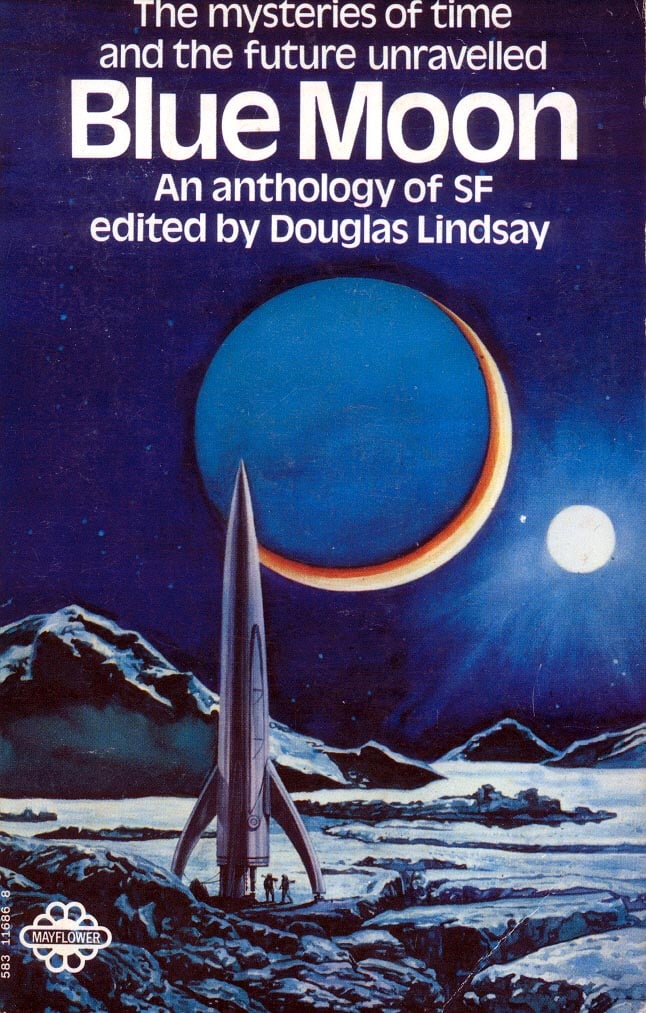 cover art by Josh Kirby
cover art by Josh KirbyGazing at it prompts me to search for ways in which one might actually justify a smart space-rocket with a pointed tip and fins.
Not that I object to more realistic designs; I have nothing against knobbly spaceships. But on reflection it occurs to me that we're just one "fix" away from the smart type being practical.
That one fix is to do with fuel. Suppose there was a super-fuel, so super that it allowed the ship to voyage from world to world and ground to ground in one economical hop, with easy un-rushed hoverings while choosing a landing site. Then it would make sense to use a design which allowed for streamlined flight in atmosphere (think of Mars, Titan and re-entry to Earth) as well as the journey through space. This all-purpose design might as well be trad and retro, as in the picture.
I don't suppose it will ever happen. Chemical energy just isn't enough. (And you don't get the satisfying rockety whoosh with atomics, or so I suppose.) But with just the one missing factor, we're tantalisingly close.
[See the 31st May Diary entry for a retraction concerning Blue Moon.]
2025 May 28th:
THE CHARON CONNECTION
Keith Laumer's great short novel Rogue Bolo (1986) presents me with a taxonomic problem of a type which I don't exactly remember encountering elsewhere.
The question concerns one little detail in a top-notch tale by someone who, at his best, was a great writer. Rogue Bolo has a natural unity, not at all like some of the fix-ups which the author indulged in during the decline he suffered after his illness during the early 1970s, and having checked online I see no reason to disbelieve that this is a true impression - in other words, 1986 really was when the story came out newly-minted. But - 1986 was well into Laumer's decline. That gives us one surprise and a bit of a puzzle: why is the book so good? Well, evidently his talent had a late flare of glory, for which his readers can be thankful.
But it also means that we need to take seriously the reference (from page 137) which I'll show here in bold, in an excerpt from a report concerning a menace detected on its approach to the Solar System:
"...special attention being given to the findings of the Oort Probe, which... returned earlier this year with samples of matter from the fringes of the Cloud, and also an additional wealth of anomalous data... it is our conclusion that what is approaching is nothing less than a new basic life form having nothing in common with life as we know it, requiring no material nourishment, subsisting in 'lethal' radiation, and having other characteristics which prompt us to think of it as Life Two.
"Life
Two is inherently incompatible with Life One, if I may so term all
organic life with which we have heretofore been familiar, including the lichens from Charon,
and is thus a plague with which there can be no accommodation, since
both Life One and Life Two, by their basic natures, must possess the
material and energy of the known Universe in order to survive. There
can be no division of spheres of influence, since the continued
existence of either would be a canker eating forever at the vitals of
the other..."
Now, by "Charon" did Laumer mean the satellite of Pluto, or did he mean, in OSS style, some fictional trans-plutonian planet of that name?
Charon was discovered in 1978. Rogue Bolo was published in 1986. Logically, we should assume that the name after 1978 was used in the up-to-date sense. But my hunch is that Laumer when writing this passage either forgot, or didn't know, about Pluto's new-found moon. We'll probably never know, but the possibility is interesting. Although it's such a minor mention in the story, it raises an intriguing point about borderline OSS: the kind of carry-over in the work of an author whose career began before the beginning of the Space Age and continued afterwards, dragging attitudes and reflexes across the historic boundary; in this case, a habit of using names mythologically associated with Pluto for trans-Plutonian planets.
I'll reiterate here that, in
mood and style, Rogue Bolo is classic Laumer, as fine as anything he ever did.
That may have a bearing on how we view his reference to "Charon" - but
I'm dashed if I know exactly how.
2025 May 10th:
FICTIONAL VERTICALITY ON LOW-GRAVITY WORLDS
You can see from my extremely well-thumbed 1963 paperback edition of Out of the Silent Planet, and from a history of selenography by Sheehan and Dobbins, examples of the way artists used to assume that low gravity would cause mountains to look like stalagmites.
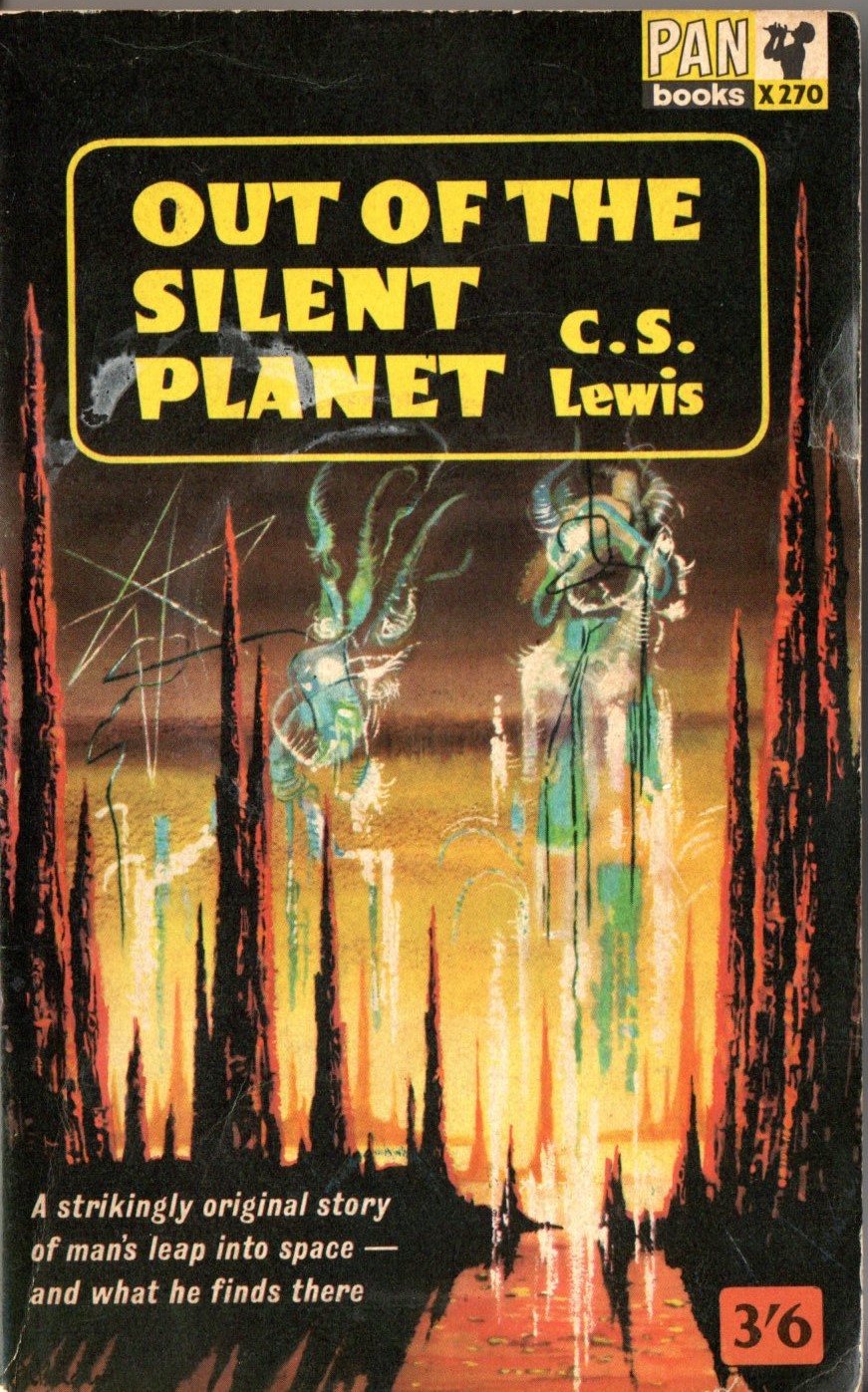
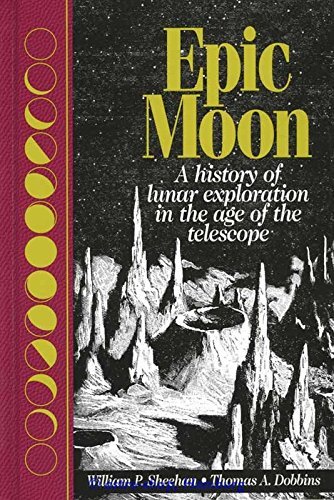
It doesn't seem to work like that in practice. Space-probe images have shown a distinct lack of vertically elongated mountains on the small worlds and moons of the System. Yet the stretched-tall theme is not a stupid idea. After all, going the other way, towards higher-gravity landscapes, no one is in much doubt that vertical relief would decrease, untll at the extremes of white-dwarf stars and (most of all) neutron stars mountains would be, at most, only inches high (see R L Forward's Dragon's Egg).
Therefore - the logical argument runs - if the higher the gravity, the dumpier the mountain, doesn't it follow that the converse, i.e. the lower the gravity, the spindlier the mountain, must be true?
Perhaps the reason it isn't, is that Earth-gravity happens to be close to the upper limit of some sort of norm which allows shapes to be their natural selves, and anything lessening of gravity does no more than decrease the weight of these "natural" shapes - it doesn't distort them.
Anyhow, the reasonable-but-wrong idea of the low-grav vertical stretch provides us with an excellent example of the latitude allowed by OSS "subordinate science" - science-as-a-departure-platform, the spring-board of a tale.
>> C S Lewis + Rugged and un-rugged Mount Pico. + themes (entries under "science")
2025 May 8th:
THE THEME-FILCHING HABIT - ANCIENT VENUS
The literature of the Old Solar System, though not scientific, is inspired by science - in fact, habitually borrows from science.
Here's a promising bit of source material - I got it by googling "Venus resurfacing 700 million years ago":
"A significant resurfacing event on Venus is estimated to have occurred roughly 700 million years ago. This event, potentially triggered by widespread volcanic activity, led to the release of carbon dioxide, transforming Venus's climate and likely contributing to a runaway greenhouse effect. A study from the University of California, Riverside suggests that Venus may have been habitable until this event, potentially hosting liquid water."
Food for thought! And in creative mode the inspired OSS writer might digest it thus:
Ah, an ancient catastrophe transforming Venus from idyll to hellishness; hey, I can use this! And the cause of the event? Volcanic activity? Bah - I'll pick my own cause! And anyhow, the important thing is, the Venusians maybe aren't extinct! They could have adapted to the disaster somehow, maybe in some sinister way, so that the form taken by their adaptation is a catastrophe in itself! Indeed that could be the moral of the tale... that they'd have been better off dead. Shudder. (See Cordwainer Smith's The Crime and the Glory of Commander Suzdal.)
Thus a writer may grab a scientific fact and go way beyond it, twisting and (as it were) lengthening it for dramatic purposes, in obedience to different laws from those of science: namely, the laws of conformity to the spirit of the OSS genre, requiring that life persist, that civilizations exist, more than they really do.
After all, material truths aren't the whole of reality. The dark energy of authorship exerts an additional force.
2025 May 7th:
TEN-YEAR PROGRESS
Now, with the statistics for yesterday available, an exact comparison can be made with the foundation-day a decade before:
|
6 May 2015 (the day the site went live) 5 visitors |
6 May 2025 (fairly typical day at present) 632 visitors |
Maybe I am rather easily impressed - being still a child at heart - but anyhow, impressed is what I definitely am, that some hundreds of readers have sufficient love for our neighbouring worlds-as-they-ought-to-be, to visit this site day after day.
"Worlds as they ought to be"? Who am I to say what they ought to be? Well, the visions undeniably exist, and were provided by hundreds of writers in a remarkable burst of creativity, a uniquely glorious achievement of the first two-thirds of the twentieth century. The phenomenon deserves notice.
And the more time goes on, the more the critics may look back and say: Hmmm.... this ought not to be taken for granted!
2025 May 5th:
THE OSS NIGHT SKY
In what respects would our night sky look different, if Mars were covered with lush vegetation, or would have looked different if our Earth had had an ancient inhabited Moon?
I came across a review by Carolyn Collins Petersen of Arthur Upgren's The Turtle and the Stars: Observations of an Earthbound Astronomer (2002) in Sky & Telescope, February 2003, p.76-7, in which these matters are raised.
The reviewer quotes:
Rich with verdure and with a higher Earthlike albedo, Mars could at rare times be bright enough to be seen rising into the daytime sky shortly before sunset, as Venus can be seen in the daytime now. An oxygen-rich full Moon would be so luminous that only the brightest stars could be seen on a clear night.
The book discusses these questions in the context of possible future terraforming, rather than the alternative reality of Old Solar System literature. We fans of the OSS can however ponder on the interesting paralellism between these alternative scenarios, both of which lead to the existence of habitable neighbouring worlds.
Some points arising:
As to how the Moon could have retained such an atmosphere for any significant length of time, well, we'd have to go into full excuse-seeking mode, and the answers I might give "off the top of my head" include a heavy unknown isotope of oxygen, and a force field created by the evolution of a biota adapted to worlds of low mass. (Remember, the science doesn't have to be rigorous; it just has to sound good enough for the story.) Mars presents a problem of colour: we're used to thinking of it as the Red Planet, and if it were the Green Planet instead, well, I wouldn't feel that was right, somehow. But wait: "verdure" needn't be literally green. The ochre moss of the dead sea-bottoms of Barsoom count as plant life, and there'd be enough of it, perhaps, to increase the planet's albedo, without impairing its traditional hue.
What else? The existence of Vulcan might make no different to what our naked eyes could detect. But a relatively fertile Twilight Belt might possibly increase the brightness of Mercury, or so I'd guess. More definitely, I bet some habitable asteroids, such as Brackett's Iskar or Clark Ashton Smith's Phocea, would show up more brightly due to their atmospheres, tenuous (or even seasonal in the case of Phocea) though they may be.
And doubtless there'd be the bustling lights of rocket-exhausts signifying the coming and going of the spaceships whose adventurous pilot the space-lanes of a lively System.
Sigh...
2025 May 3rd:
THE UNCHRONICLED WORLD
Concentration brought about by the looming anniversary has resulted in my being reminded of a gap in this site's coverage of the Solar System.
With one main exception, the coverage has been pretty adequate. During the ten years this site has been in existence, it has ranged over the Sun, the nine planets and quite a few of the major asteroids, and almost all of the important known pre-probe moons.
The exception is one of those moons: Saturn's Hyperion.
Every now and then I've checked online in case "Saturn's satellite Hyperion in fiction" brings anything up. So far, nothing relevant. I've found references to Dan Simmons' Hyperion series, but there it seems that the name refers to an extrasolar planet.
A bit frustrating! Let's hope a real Hyperion tale is discovered. It would be great, following that, to include a scene from it in Guess The World, and thence create a "What to see on Hyperion" page. Alternatively I myself could write a story to fit the bill; but the trouble is, since retirement I'm busier than ever. How about you writers and fans? Anyone feel like helping out?
Just think your way into the Old Solar System, in which a low-cost Bradbury-style rocket ought to be enough to get your protagonist out Saturn way, to stir up some adventure on the ringed planet's hitherto-neglected seventh moon, and reduce the count of Tales Unwritten.
2025 May 2nd:
THE TENTH ANNIVERSARY APPROACHES
As we time-travel at the rate of 60 seconds a minute towards the 6th of this month, we can picture the various imaginary denizens of the Sun's family of worlds as they prepare to celebrate ten years of the website which is dedicated to promoting their imaginary existence. Fireworks are due to soar into various skies from Vulcan to Planet X. Limbs, tentacles and pseudopodia are already a-wave with enthusiasm since we are now in the Tenth Anniversary Month of Solar System Heritage. And what will happen on the actual 6th of May?
Ideally, the planet Mercury should cease to rotate, in conformity with its proper image; Venus should acquire some oceans and jungles; Mars should shake off its deviations from the pre-probe canal-network norm.
And for that matter, Earth could do with some reform as well; for instance, it should be easier than it is to acquire a spaceship and a private rocket-pilot's licence...
2025 April 25th:
PRE-HUMAN TERRAN CIVILIZATIONS
Lovecraft's multi-million-year perspectives on Earth history, in At the Mountains of Madness and The Shadow Out of Time, raise the question, could it be true in fact that we humans are not the first Earthlings to achieve a technically advanced civilization?
A comment on John Greer's "Ecosophia" blog put me on to a link to a scientific article which takes the idea seriously. To be more specific: the authors discuss the likelihood of physical evidence surviving if such a civilization had existed many millions of years ago; evidence in the form of substances of artificial orgin and also possible signs of technologically-caused climate change.
The article is The Silurian Hypothesis. ("Silurian" here does not refer to the geological period; it is a science-fictional reference.)
Wouldn't it be ironic if the first non-human technological culture to be discovered turned out to be, not on any exoplanet, but on ancient Earth!
2025 April 11th:
ARTISTIC OVERLAP
I suppose that an RSS / OSS overlap is far more likely to occur in pictures than in stories. An artist's urge to emphasize beauty in a scene is liable to edge it towards the romantic. Of course, one can't claim that RSS pictures can rival imaginative productions such as Frank R Paul's Europa...
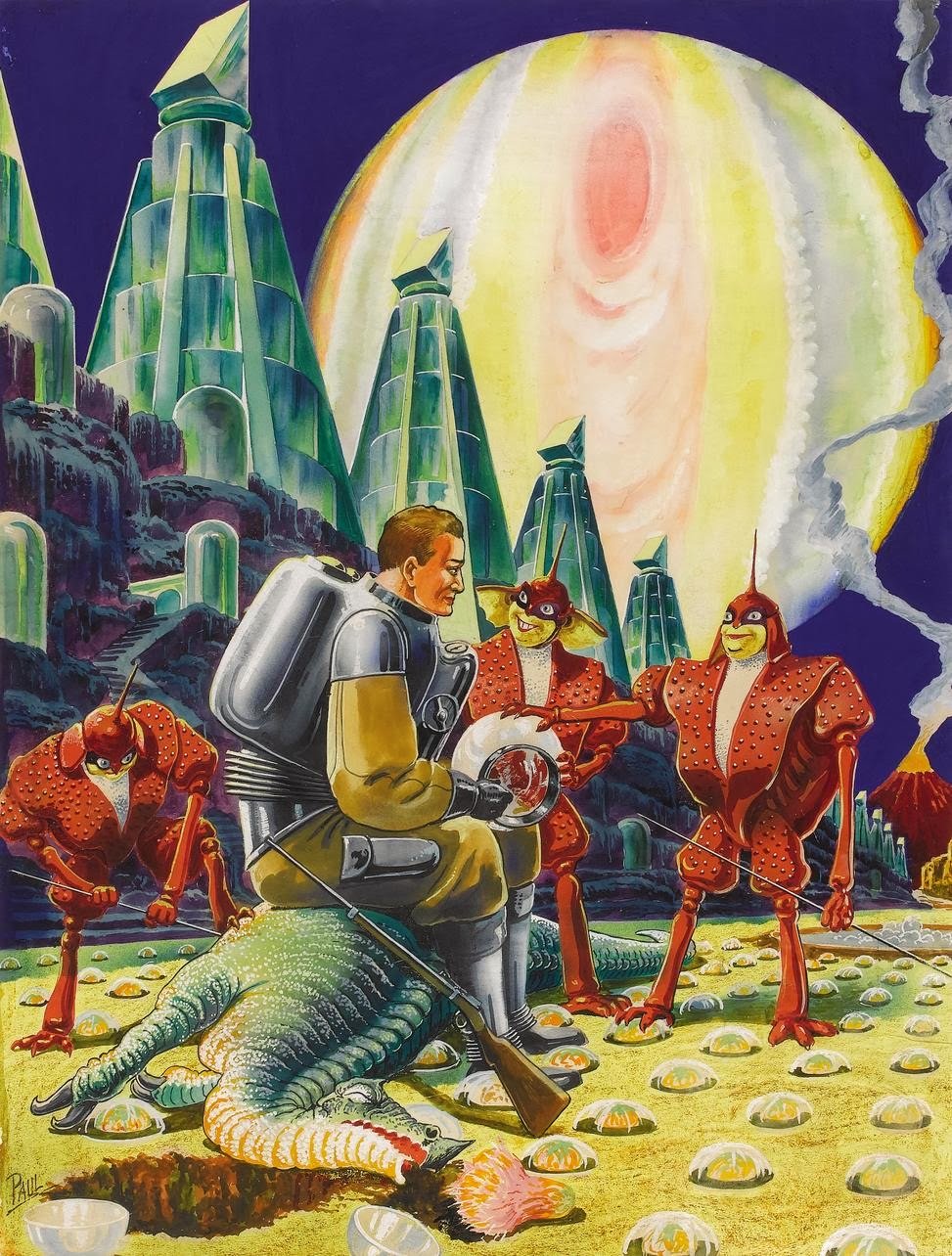
...but nevertheless some landscapes make one reflect along nostalgic lines. By chance I was looking at a fairly modern interplanetary-themed artist's impression - a painting by Joe Bergeron of a scene on that same Jovian moon - when it occurred to me that although the picture is definitely "RSS" (Realistic Solar System), it would not have been out of place in the Old Solar System. I think it's the colour that does it. Whether the idea is that the water is full of minerals, or whether the meaning is organic in some way, the mood of the scene is sufficiently un-boring to be linked to the OSS. In my opinion, anyway. Here is Bergeron's Europa:
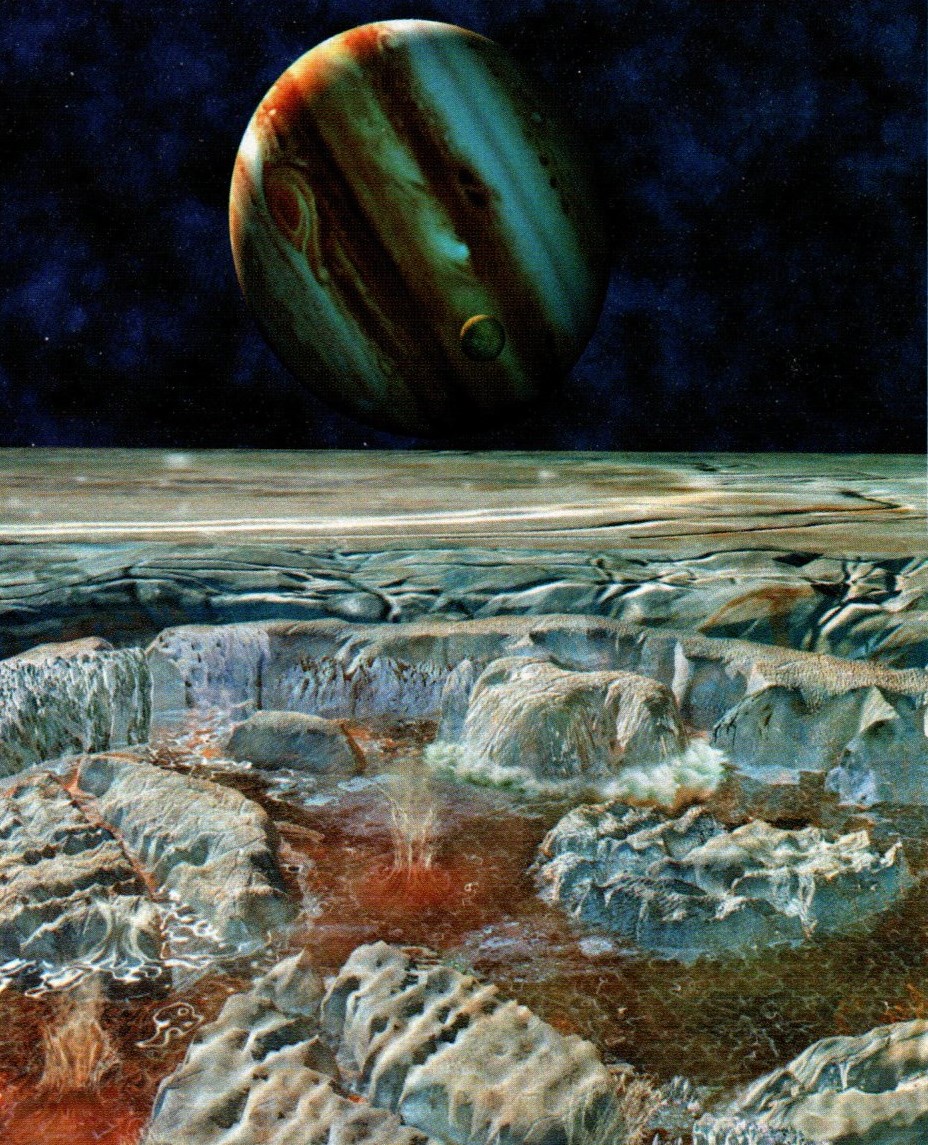
I miss the friendly-aunt-like natives in Paul's version, but still, the other one has something... and who knows with what significance I might have peopled it if I had viewed it as a child.
2025 March 23rd:
THE JULIAN DATE AND URANIAN CULTURE
An oddity about Ooranye, my invented version of Uranus, is that its inhabitants date their events using long numbers based on a count of days. Understandable, in a way, insofar as years would be too long - a Uranian year lasts about a lifetime; still, you'd think they might have bothered to invent some intermediate unit of time, rather like we Terrans invented the week. But there it is. No accounting for cultural quirks. I disclaim all responsibility - an author is a mere channel of ideas from Heaven knows where...
From a personal point of view, one surprising aspect of all this is that heretofore I never considered the parallel, or echo, of such a system here on Earth, namely the Julian-date count. This is a continuous reckoning of the days elapsed since noon on 1st January 4713 BC.
To quote Wiki:
"The Julian day is a continuous count of days from the beginning of the Julian period; it is used primarily by astronomers, and in software for easily calculating elapsed days between two events (e.g. food production date and sell by date)."
As to why that particular start-date was chosen, here's Wiki again:
"The Julian period is a chronological interval of 7980 years, derived from three multi-year cycles: the Indiction, Solar, and Lunar cycles. The last year that was simultaneously the beginning of all three cycles was 4713 BC (−4712), so that is year 1 of the current Julian period, making AD 2025 year 6738 of that Period. The next Julian Period begins in the year AD 3268."
Why the "Indiction" cycle comes into it, I can't guess. It was something to do with taxation in antiquity, if I'm not mistaken, and hence not astronomical at all. Never mind: 4713 BC is far enough back to be useful as a starting-point that allows a long string of positive numbers which easily covers all of recorded history.
Right now it happens to be "2,460,755" here on Earth. On Ooranye it'll be somewhere in the ten millions of the days of the Actinium Era.
Oh well, why not? If the Germans can stretch their brains to cope with words like Rindfleischetikettierungsüberwachungsaufgabenübertragungsgesetz ("law delegating beef label monitoring") why shouldn't humanoids be able to wield 7-digit dates? To do so makes us eligible for the reward, namely, their rather exotic ring.
2025 March 13th:
JACKANORY
Jackanory
was the name of a children's TV program, 1965-96, which featured
stories being read out by the presenter - a different presenter every
week.
Jackanory, therefore, is the name Mary and I give to our
daily reading-to-each-other session, a tradition we've begun this year.
In a 15-20 minute "programme" we get through 5-10 pages, an amount that
varies
according to the natural breaks in the narrative. I look forward very
much to these sessions.
Mary is not a bookish person like me, but she is
enjoying our Jackanories, in which I am introducing her to some science
fiction classics.
First, before the sf, we read through C S
Lewis' wonderful allegory A Pilgrim's Regress. Then, on to sf with The Sands of
Mars, which we finished yesterday. This evening I started on Clifford
Simak's All The Traps of Earth, because I know that my wife likes cuddly robots...
I've found The Sands of Mars to be wholly
suitable as an sf novel to read to a gentle, kindly, positive
woman with no liking for violence or weirdness, real or imagined. Clarke's novel is unique in my experience in that it relies on a
sense of wonder that comes not from conflict but from positive achievement and a sense of
communal effort in a great enterprise, the colonization of a Mars that is
gripping just because it is Mars, with the character of "Mars-ness" as the only needful exciting thing, and no blood-and-thunder effects required. I never cease to be impressed at the superb job Arthur C Clarke made of a nuts-and-bolts, practical, colony-building tale.
Thank goodness this 1950s masterwork could slip through the clocking crack in the continuum. In the subsequent yuck-deluge nobody could have written such a book; certainly not Clarke himself, who lost his best self in the second half of his life.
2025 February 20th:
PHASE CHANGE ON PLUTO
"There's tungsten here," observed the older man hopefully, gazing down at the black expanse. "Hervey reported it, and so did Caspari. But there isn't any atmosphere, or rather, what there is, is liquid or solid, except about half a centimeter's pressure of helium. Pluto has a diameter of about ten thousand miles, a surface gravity of about 1.2, and an albedo—"
I cite the above passage from Stanley G Weinbaum's The Red Peri (Astounding Stories, November 1935) as an example of how Pluto used to be believed to be much larger than we now know. Much, much larger. 10,000 miles is a lot more than 1,473 miles!
Yet, remarkably, the Weinbaum Pluto has remained within the permissible boundaries of literary Pluto. Somehow, the huge uncertainty about the planet's size has worked its way into the acceptable OSS image of that world, so that the tale succeeds in its own terms, whereas such latitude would not be allowed to the other planets: imagine for instance that a similar size-disparity were attempted by a storyteller when the subject was the planet Mars: we as readers wouldn't accept it. Much is allowed in the OSS - a Mars with a breathable atmosphere, a Mars with native humans - but a Mars over six times smaller, or larger, than the real Mars would not be recognizably the Red Planet at all, in fiction no more than in fact.
You may say that this is a non-issue, since Mars' size has been known for centuries, whereas science had not until recently discerned the basic characteristics of far more distant Pluto. However, my point concerns the consequence of that unequal record; its effect upon the process whereby a world's character takes shape in the imagination of the readership. In this regard Pluto, endowed with the radical mystery of its distance and faintness, has succeeded in winning for itself so much extra leeway that you could, even now, write a neo-OSS tale about a version of it with a diameter of 10,000 miles. Admittedly, the author might be wise to include a bit of nifty excuse-making. Here are a couple of suggestions as to how it might be done.
During your spaceship's approach to Pluto you might have your pilot draw attention to a fuzzy highlight on the Sun-facing hemisphere, and say that telescopes upon Earth were long fooled into thinking that the comparatively bright spot was the whole of the planet. Hence they vastly underestimated its diameter.
Or, the diameter might really have changed. This is the option I like best: that the ice (or whatever) of which Pluto is composed has recently undergone drastic phase-changes which first decreased and then increased its volume, finally bringing it back to the 10,000 mile diameter it had when Tombaugh discovered the planet in 1930. Now, were you about to object that such alterations in a world would release so much energy that it would blow up? Ah, but the Plutonians had thought of that. In their desperate, life-and-death struggles against their foes from the Outermost Reaches, they were able to apply a [blah, blah] field to inhibit the destructive energies involved...
There are times when the possession of [blah, blah] is absolutely vital.
2025 January 24th:
THE SINGLETON SOLARIANS
Last night, while re-reading Charles Williams' weird novel about anti-intellectualism, revolution and will-power, Shadows of Ecstasy (1931), I found the following great sentence on page 36:
A thing that seemed had at least the truth of its seeming.
Worth pondering, that, and vital to the philosophy of Old Solar System literature...
Coincidentally
I had also been re-perusing the February 2001 issue of Sky &
Telescope, which inspired me to wonder what excuses might allow one to use, in a story, the
magazine's awesome images of scenes on the sun.
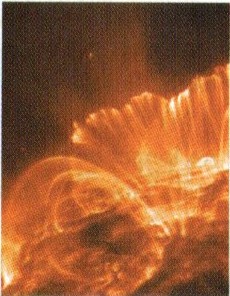
The beautiful scenes cry out to count as landscapes for a narrative; but how? They aren't lands; they're plasmic maelstroms of forces, changing momently with a violence we can't imagine.
All right: here's how I suggest we do it. Three aspects we can make fit for narrative by focusing on one instant:
1: The singleton shapes, each momently unique.
2: The singleton positional patterns of the shapes in combination.
2: The singleton locations, each place different from every other place.
And who's to say how long a moment instant lasts? In Dragon's Egg by R L Forward, the neutron star's inhabitants live their full lives in about half an hour. Our own Solarians might live a life that seems long to them during one of our mere instants - in a scene that, to them, seems solid in its flash of stability.
After all, if every seeming thing has the
truth of its seeming, then an author who sees a landscape on the Sun
has the right to follow that idea.
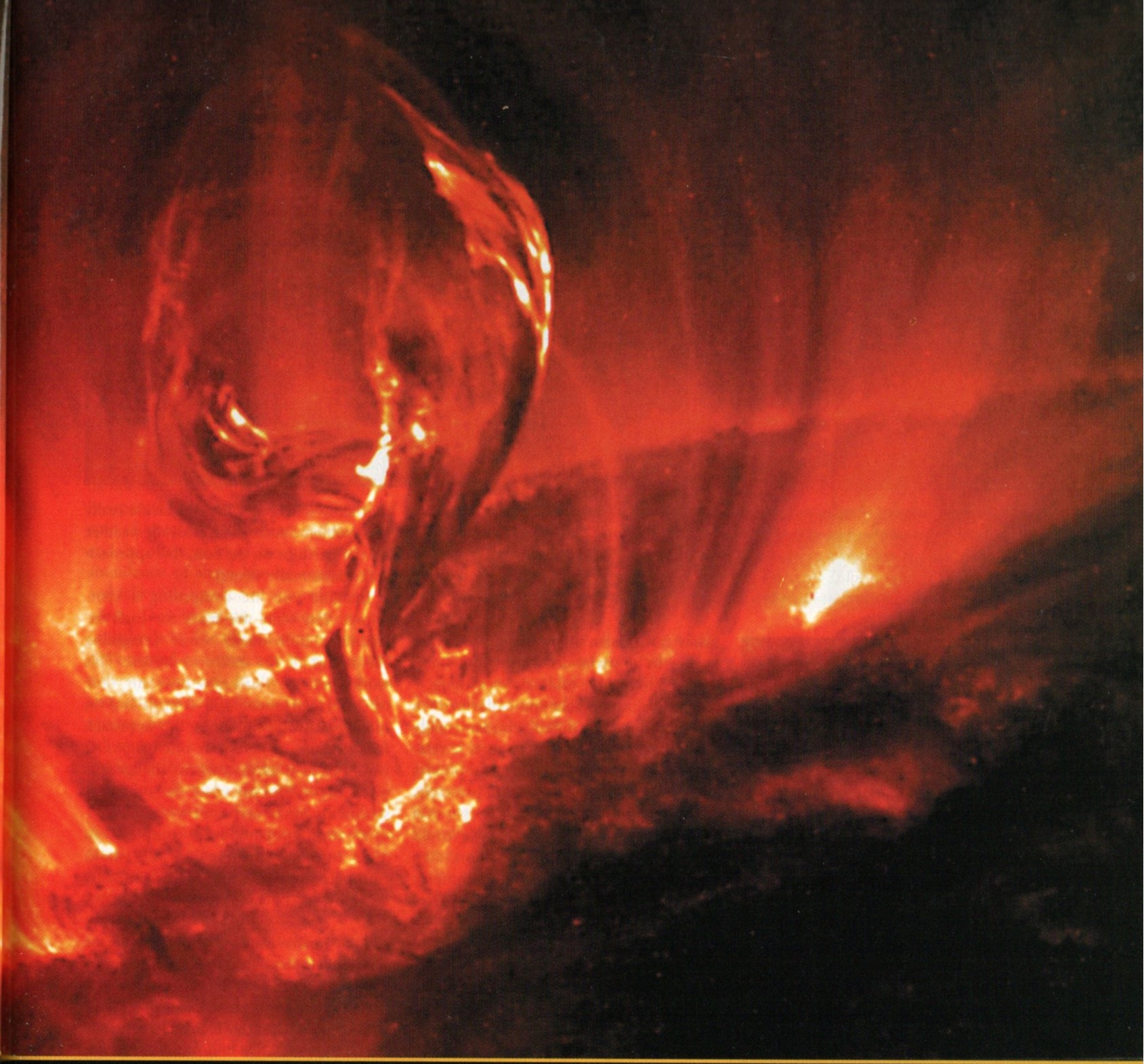
2025 January 22nd:
WHERE NEXT?
As readers may have noticed, I am gradually transferring to the site the texts of my books which are now out of print. By count of titles, I am now a third of the way through the task (Uranian Gleams and Valeddom done; still to come are the volumes of the Kroth trilogy plus Man of the World). It's a long job because I'm free to revise as I go - a second chance which in its way is most welcome.
The question now is, which to embark upon next? If I choose Man of the World, it will mean first of all going over the chapters (17 out of the 37) which are already on site. That sort of gives me a run-up. If on the other hand I choose Kroth, then I'm putting new stuff on site from the word go.
The thing to do is to sleep on it...
Expanding away from considerations of my own work, a theme which often causes me to wonder is: how far did my favourite authors know their own strengths and weaknesses? Those whose performance deteriorated in the later part of their careers: were they just getting tired, or is the slump in quality a proof that they never understood what made them great in the first place?
I suspect the latter.
How far can one assess oneself at all? I believe my worst story is Outlaws of Neptune; it's the one that would cause me to go down on my knees and beg for it not to be included in an anthology (infinitesimal chance). But then why haven't I deleted it from the site? Because... it's not actually doing any harm, and anyhow, I simply don't know...
2025 January 20th:
A BIRTHDAY GIFT
I'm 71 today and my wife Mary has given me a book called Clark Ashton Smith: A Critical Guide to the Man and his Work by Steve Behrens (The Borgo Press, 2013).
It's 217 pages long and I'm on page 50. It's well worth reading. The trouble with trying to write about Smith is that paucity of knowledge about the man makes it hard to write a fully detailed biography, but Behrens does reveal quite a bit, and besides, he is good at discussing the stories, which are the main reason why we bother to remember CAS at all: namely, as the "emperor of dreams", a unique author of the colourfully fantastic.
Behrens makes good points, for example rightly emphasizing the sense of loss which the tales so often convey. My one caveat so far, is that the reader new to CAS might get the wrong idea from phrases such as "Smith's stress on mood, at the expense of action..." I know what he means, but it's misleading to put it like that. It might make some readers think that not much happens in the stories. Really, if you were transported into the role of protagonist in (for example) a Zothique or Averoigne tale, you'd certainly feel pretty soon that quite enough was happening to you!
Indeed, what Smith's moody settings ensure is that the events in them seem all the more real.
2025 January 19th:
NORSE MYTH, MERCURY AND THE PRIMORDIAL OSS
The latest email in my inbox from researcher and Guess The World contributor Lone Wolf has filled my head with a burst of ideas that beg for further development:
I have often thought recently what a pity it is that nobody has noticed the similarity between, on the one hand, the Old Mercury with its synchronous rotation and two distinct hemispheres, and on the other the cosmic model of the old Norse myths with its Muspelheim ("Flame-World"), Niflheim ("Mist-World") or Myrkheim ("Dark-World") where the frost giants live, and between them the middle earth of the humans called Midgard (lit. "Middle Wall"), encircled by the world serpent ("Midgard's Worm"), which causes the tides, and which could be a suitable image for the Twilight Belt.
This could provide such an epic setting for a story, be it a kind of other-planet fantasy, like The Worm Ouroboros which is supposed to be set on Mercury but in fact doesn't seem like it at all, or something along the lines of the ancient astronauts theory with a fictional history of the pre-human races in the Old Solar System. Thus, the Aesir could really have been gods of the ancient Mercurian civilization, who genetically engineered the Mercurian humans; the other gods or Vanir from Vanaheim might have been Venusians; there could also have been the Yötuns or giants from the outer planets or their moons - in fact, in the Edda, their homeland is called Yötunheimar /plural!/ or "Worlds of Giants", etc.
Well, I guess a story like that could still be written someday, but it would never produce such an impact which it could have had if it had been written when the Old Mercury with its Twilight Belt was considered astronomical fact. It might even have been proclaimed a plausible hypothesis of the ancient forgotten past, some of the stories of the golden age being advertised as such in the pulp magazines (like the moon stories of O.A. Kline, E. Hamilton and R. H. Romans, not to mention the famous hoax of the "Shaver Mystery"), whereas nowadays it would be only an eccentric fantasy... (Of course, it could be on Venus too - the old model of Schiaparelli with synchronous rotation, but this one is much less known and the notion about a planet with Dayside and Nightside in the SF is habitually associated with Mercury. In fact I can name only 3 authors who wrote about synchronous-rotating Venus - Garrett P. Serviss, Clark Ashton Smith and Stanley G. Weinbaum.)
My most immediate response to all this is an excited suspicion that Lone Wolf has perhaps understated his case. The tales as yet unwritten on the Norse-myth theme he suggests might actually work every bit as well as they could have done in the pulp era. In fact they might work even better - because the author would be under some extra creative pressure to justify the way the scenario contradicts current scientific claims. Under that pressure, and in the hands of a powerful writer, the result could be tremendous.
To sum up: imagine ancient OSS-style Mercury, with two powerful native races, one on Dayside and one on Nightside. One or both of them mould some life-plasm into humanoid servants (like the Old Ones did in Lovecraft's At the Mountains of Madness). Note that these humans would be real Mercurians, because they would have been created by Mercurians; no hint of COMOLD here. And as time goes on... well, anything might happen as time goes on!
2025 January 10th:
HITCH-HIKING FROM WORLD TO WORLD
This is just a quickie to say that I chanced across a tale in my shelf of sf magazines, which I had not noticed before (it still happens), and which made me catch my breath in admiration for the audacity of the concept. The story is by Ray Bradbury and it is called Rocket Skin (Thrilling Wonder Stories, Spring 1946). In it, people hitch rides on rockets by clamping themselves magnetically onto the hulls! About as far from realistic hard-science sf as you can get, I reckon.
If I had known of this idea when writing the page on Plying the spacelanes, would I have included a mention of it? Probably. I could have drawn an analogy between this sort of unorthodox travel and the "running the rails" by hoboes during the Great Depression. Considerably more risky, though.
...Another hitch-hiker swam up out of the dark sky ocean and strove to connect. George screamed him on. The man failed. He dove straight into the river of jet-flame!
Something to add to your not-to-do list.
2025 January 4th:
A GHOSTLY NUDGE FROM JUPITER
Without consciousness there would be no science, so let's view science as one mental construct, while fiction is another. In fact, consider them as two dimensions of reality (fiction itself being a definite reality inside our heads whatever the accuracy or inaccuracy of its outside references).
In my current phase of browsing through my collection of astronomy magazines I came across an article titled Jupiter's Deep Mystery, by Thomas Dobbins and William Sheehan (Sky & Telescope, December 1999, p118-23), which make me feel as if the OSS solid-surface version of the planet - the view of it as a world with explorable places on it - were stretching out a ghostly tentacle to make my spine tingle with the idea, "Perhaps it's true after all".
Not quite enough to
materialise a real hope, but at least an approach, the ghostly haunting
of a nearness to hope, is provided by some
observations of the South Equatorial Belt (SEB).
What brought me up sharp was to learn that eruptions in the SEB, when
timed, have appeared to synchronize with the giant
planet's axial rotation in such a way as to suggest a fixed origin
somewhere down below!
To quote from the article:
...Surprisingly, our deepest insight into the mechanism and meaning of SEB revivals is not the brainchild of a theoretical astrophysicist but of an amateur astronomer, Elmer J. Reese. Although he now lives in quiet retirement in Longview, Texas, Reese was a prolific contributor to the Association of Lunar and Planetary Observers (ALPO) during the heyday of amateur planetary studies in the 1950s and early 1960s...
...Despite the fact that most of Reese's observations were made with a humble 6-inch Newtonian reflector, his work was of such high quality that he was able to make the transition from amateur to professional astronomer. In 1963 he was asked to join the staff of New Mexico State University Observatory...
...He reasoned that because these phenomena [SEB revivals] "invariably begin with the sudden appearance of a small dark spot near the latitude of the middle of the South Equatorial Belt, we might infer that material reaches the visible surface from an eruption of some kind..."
Then, confirmation of the idea that the source of the eruptions is fixed in the solid core of the planet came from subsequent correlation with output from Jovian radio sources. Bingo!
Too good to be true, maybe, but still, mysterious and suggestive - and who really knows what's down there?
...According to John Rogers, Director of the Jupiter Section of the British Astronomical Association (BAA), the Reese sources are "sites of potential instability at which SEB eruptions tend to be triggered, but, given our present knowledge of the planet, they cannot be 'volcanoes' as originally envisaged. They might perhaps be long-lived circulations or waves or even floating objects at a deep level... Whatever the Reese sources may be, the instability always breaks first over them, just as clouds on Earth first form over mountains."
So there you are. Next step: revise, amend, or refute our "present knowledge of the planet"!
